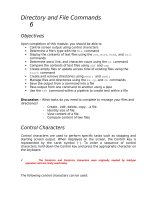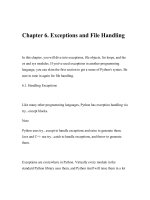Interruptions and file managing
Bạn đang xem bản rút gọn của tài liệu. Xem và tải ngay bản đầy đủ của tài liệu tại đây (94.2 KB, 28 trang )
5 Interruptions and file managing
Contents
5.1 Internal hardware interruptions
5.2 External hardware interruptions
5.3 Software interruptions
5.4 Most Common interruptions
5.1 Internal hardware interruptions
Internal interruptions are generated by certain events which come during the execution
of a program.
This type of interruptions are managed on their totality by the hardware and it is not
possible to modify them.
A clear example of this type of interruptions is the one which actualizes the counter of
the computer internal clock, the hardware makes the call to this interruption several
times during a second in order to maintain the time to date.
Even though we cannot directly manage this interruption, since we cannot control the
time dating by means of software, it is possible to use its effects on the computer to our
benefit, for example to create a "virtual clock" dated continuously thanks to the clock's
internal counter. We only have to write a program which reads the actual value of the
counter and to translates it into an understandable format for the user.
5.2 External hardware interruptions
External interruptions are generated by peripheral devices, such as keyboards, printers,
communication cards, etc. They are also generated by coprocessors. It is not possible
to deactivate external interruptions.
These interruptions are not sent directly to the CPU, but rather they are sent to an
integrated circuit whose function is to exclusively handle this type of interruptions. The
circuit, called PIC8259A, is controlled by the CPU using for this control a series of
communication ways called paths.
5.3 Software interruptions
Software interruptions can be directly activated by the assembler invoking the number
of the desired interruption with the INT instruction.
The use of interruptions helps us in the creation of programs, and by using them our
programs are shorter, it is easier to understand them and they usually have a better
performance mostly due to their smaller size.
This type of interruptions can be separated in two categories: the operative system DOS
interruptions and the BIOS interruptions.
The difference between the two is that the operative system interruptions are easier to
use but they are also slower since these interruptions make use of the BIOS to achieve
their goal, on the other hand the BIOS interruptions are much faster but they have the
disadvantage that since they are part of the hardware, they are very specific and can
vary depending even on the brand of the maker of the circuit.
The election of the type of interruption to use will depend solely on the characteristics
you want to give your program: speed, using the BIOS ones, or portability, using the
ones from the DOS.
5.4 Most common interruptions
Contents
5.4.1 Int 21H (DOS interruption)
Multiple calls to DOS functions.
5.4.2 Int 10H (BIOS interruption)
Video input/output.
5.4.3 Int 16H (BIOS interruption)
Keyboard input/output.
5.4.4 Int 17H (BIOS interruption)
Printer input/output.
5.41 21H Interruption
Purpose: To call on diverse DOS functions.
Syntax:
Int 21H
Note: When we work in TASM program is necessary to specify that the value we
are using is hexadecimal.
This interruption has several functions, to access each one of them it is necessary that
the function number which is required at the moment of calling the interruption is in the
AH register.
Functions to display information to the video.
02H Exhibits output
09H Chain Impression (video)
40H Writing in device/file
Functions to read information from the keyboard.
01H Input from the keyboard
0AH Input from the keyboard using buffer
3FH Reading from device/file
Functions to work with files.
In this section only the specific task of each function is exposed, for a
reference about the concepts used, refer to unit 7, titled : "Introduction
to file handling".
FCB Method
0FH Open file
14H Sequential reading
15H Sequential writing
16H Create file
21H Random reading
22H Random writing
Handles
3CH Create file
3DH Open file
3EH Close file driver
3FH Reading from file/device
40H Writing in file/device
42H Move pointer of reading/writing in file
VIDEO DISPLAY FUNCTIONS
02H FUNCTION
Use:
It displays one character to the screen.
Calling registers:
AH = 02H
DL = Value of the character to display.
Return registers:
None.
This function displays the character whose hexadecimal code corresponds to the value
stored in the DL register, and no register is modified by using this command.
The use of the 40H function is recommended instead of this function.
09H FUNCTION
Use:
It displays a chain of characters on the screen.
Call registers:
AH = 09H
DS:DX = Address of the beginning of a chain of characters.
Return registers:
None.
This function displays the characters, one by one, from the indicated address in the
DS:DX register until finding a $ character, which is interpreted as the end of the chain.
It is recommended to use the 40H function instead of this one.
40H FUNCTION
Use:
To write to a device or a file.
Call registers:
AH = 40H
BX = Path of communication
CX = Quantity of bytes to write
DS:DX = Address of the beginning of the data to write
Return registers:
CF = 0 if there was no mistake
AX = Number of bytes written
CF = 1 if there was a mistake
AX = Error code
The use of this function to display information on the screen is done by giving the BX
register the value of 1 which is the preassigned value to the video by the operative
system MS-DOS.
KEYBOARD INFORMATION FUNCTIONS
01H FUNCTION
Use:
To read a keyboard character and to display it.
Call registers
AH = 01H
Return registers:
AL = Read character
It is very easy to read a character from the keyboard with this function, the hexadecimal
code of the read character is stored in the AL register. In case it is an extended register
the AL register will contain the value of 0 and it will be necessary to call on the function
again to obtain the code of that character.
0AH FUNCTION
Use:
To read keyboard characters and store them on the buffer.
Call registers:
AH = 0AH
DS:DX = Area of storage address
BYTE 0 = Quantity of bytes in the area
BYTE 1 = Quantity of bytes read
from BYTE 2 till BYTE 0 + 2 = read characters
Return characters:
None.
The characters are read and stored in a predefined space on memory. The structure of
this space indicate that in the first byte are indicated how many characters will be read.
On the second byte the number of characters already read are stored, and from the
third byte on the read characters are written.
When all the indicated characters have been stored the speaker sounds and any
additional character is ignored. To end the capture of the chain it is necessary to hit
[ENTER].
3FH FUNCTION
Use:
To read information from a device or file.
Call registers:
AH = 3FH
BX = Number assigned to the device
CX = Number of bytes to process
DS:DX = Address of the storage area
Return registers:
CF = 0 if there is no error and AX = number of read bytes.
CF = 1 if there is an error and AX will contain the error code.
FILE WORKING FUNCTIONS:
FCB FUNCTIONS:
0FH FUNCTION
Use:
To open an FCB file
Call registers:
AH = 0FH
DS:DX = Pointer to an FCB
Return registers:
AL = 00H if there was no problem, otherwise it returns to 0FFH
14H FUNCTION
Use:
To sequentially read an FCB file.
Call registers:
AH = 14H
DS:DX = Pointer to an FCB already opened.
Return registers:
AL = 0 if there were no errors, otherwise the corresponding error code will be returned:
1 error at the end of the file, 2 error on the FCB structure and 3 partial reading error.
What this function does is that it reads the next block of information from the address
given by DS:DX,
What this function does is that it reads the next block of information from the address
given by DS:DX, and dates this register.
15H FUNCTION
Use:
To sequentially write and FCB file.
Call registers:
AH = 15H
DS:DX = Pointer to an FCB already opened.
Return registers:
AL = 00H if there were no errors, otherwise it will contain the error code: 1 full disk or
read-only file, 2 error on the formation or on the specification of the FCB.
The 15H function dates the FCB after writing the register to the present
block.
16H FUNCTION
Use:
To create an FCB file.
Call registers:
AH = 16H
DS:DX = Pointer to an already opened FCB.
Return registers:
AL = 00H if there were no errors, otherwise it will contain the 0FFH value.
It is based on the information which comes on an FCB to create a file on a disk.









